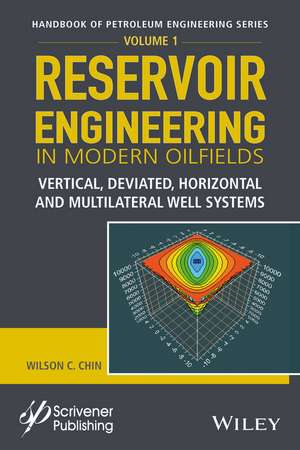Reservoir Engineering in Modern Oilfields – Vertical, Deviated, Horizontal and Multilateral Well Systems: Handbook of Petroleum Engineering
Autor W Chinen Limba Engleză Hardback – 26 sep 2016
And what if it were further possible to sketch complicated geologies and lithologies, plus equally complex systems of general wells, layer-by-layer using Windows Notepad? And with no prior reservoir simulation experience and only passing exposure to reservoir engineering principles? Have the user press "Simulate," and literally, within minutes, produce complicated field-wide results, production forecasts, and detailed three-dimensional color pressure plots from integrated graphics algorithms?
Developed over years of research, this possibility has become reality. The author, an M.I.T. trained scientist who has authored fifteen original research books, over a hundred papers and forty patents, winner of a prestigious British Petroleum Chairman's Innovation Award in reservoir engineering and a record five awards from the United States Department of Energy, has delivered just such a product, making real-time planning at the well-site simple and practical. Workflows developed from experience as a practicing reservoir engineer are incorporated into "intelligent menus" that make in-depth understanding of simulation principles and readings of user manuals unnecessary. This volume describes new technology for down-to-earth problems using numerous examples performed with our state-of-the-art simulator, one that is available separately at affordable cost and requiring only simple Intel Core i5 computers without specialized graphics boards. The new methods are rigorous, validated and well-documented and are now available for broad petroleum industry application.
Preț: 1099.05 lei
Preț vechi: 1636.74 lei
-33% Nou
Puncte Express: 1649
Preț estimativ în valută:
210.30€ • 220.16$ • 174.01£
210.30€ • 220.16$ • 174.01£
Carte indisponibilă temporar
Doresc să fiu notificat când acest titlu va fi disponibil:
Se trimite...
Preluare comenzi: 021 569.72.76
Specificații
ISBN-13: 9781119283782
ISBN-10: 1119283787
Pagini: 352
Dimensiuni: 176 x 240 x 24 mm
Greutate: 0.59 kg
Editura: Wiley
Seria Handbook of Petroleum Engineering
Locul publicării:Hoboken, United States
ISBN-10: 1119283787
Pagini: 352
Dimensiuni: 176 x 240 x 24 mm
Greutate: 0.59 kg
Editura: Wiley
Seria Handbook of Petroleum Engineering
Locul publicării:Hoboken, United States
Public țintă
Reservoir engineers, petroleum engineers, and any engineers or scientists involved in simulation and well characterizationNotă biografică
Wilson C. Chin earned his Ph.D. from M.I.T. and his M.Sc. from Caltech. He has published fifteen books describing his original research in reservoir engineering, formation testing, managed pressure drilling, wave propagation, Measurement While Drilling (MWD) and electromagnetic well logging, over one hundred papers and three dozen patents. Mr. Chin has consulted for well known domestic and international oil and gas corporations, and during the past two decades, won five prestigious research contracts and awards in petroleum exploration and production with the United States Department of Energy.
Descriere
Real-world reservoirs are layered, heterogeneous and anisotropic, exposed to water and gas drives, faults, barriers and fractures.
